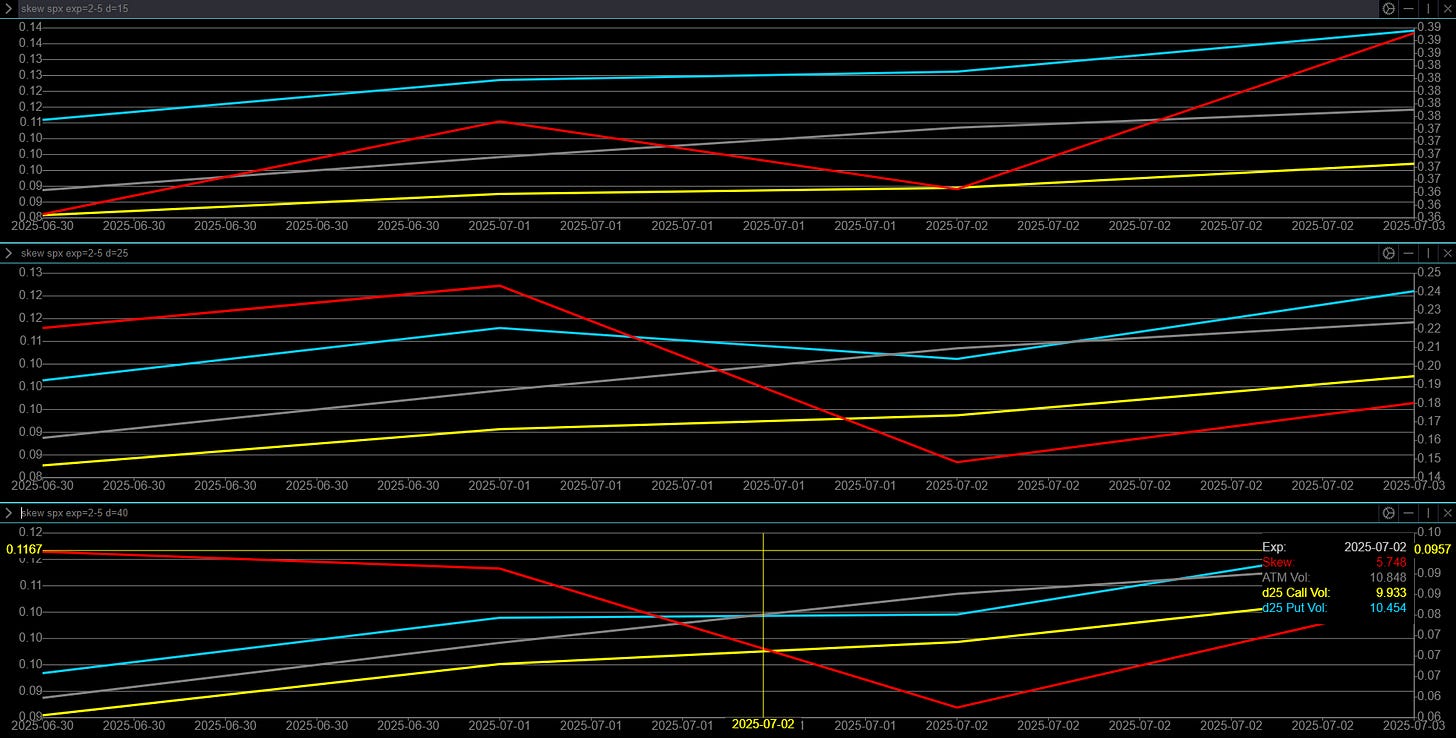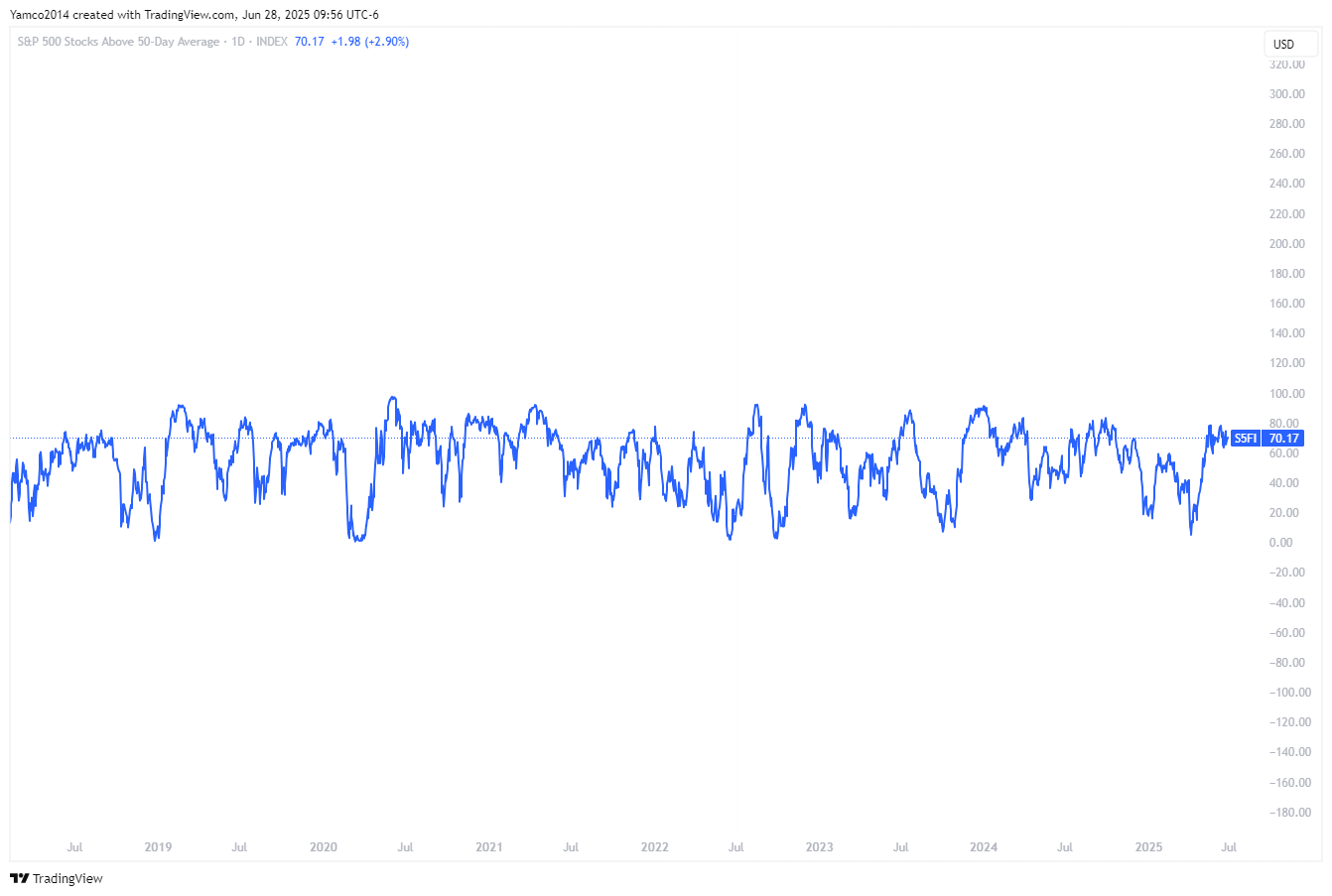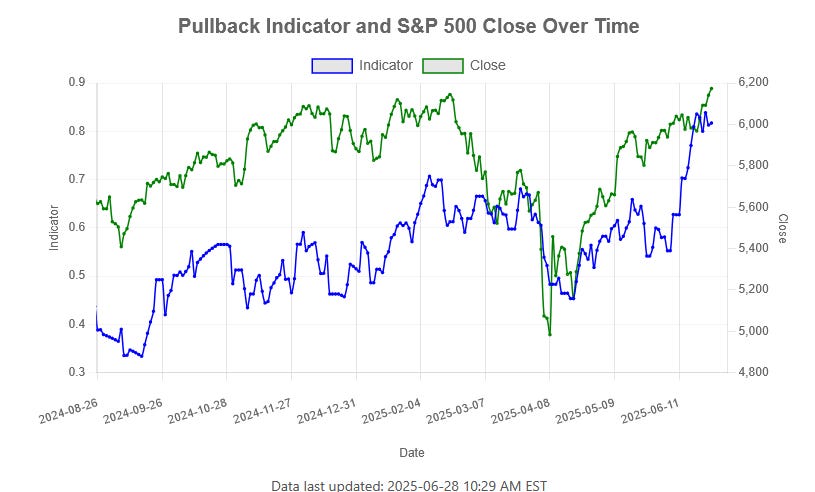Weekly Review is linked below:
Looking into next week, we have several big events (taken from Investing.com). Tariff extension talks have been mentioned while talks about what countries owe have been discussed. Let’s see what ends up happening there. There have also been comments by the administration that the BBB will be signed by Thursday. If that’s the case, I’m sure the market is going to go nuts into a holiday weekend… because America! Those two events aside, the focus this week is on the jobs report - With a cool PCE and a slightly weakening labor market, that provides the fuel for the Fed to cut (or so the market is hoping).
All times are in EST
Sunday
Chinese PMI (2130)
Monday
UK GDP (0200)
German CPI (0800)
Chicago PMI (0945) - right after market open
Tuesday
EUR CPI (0500)
Powell Speaks (0930)
S&P PMIs & ISM Manufacturing PMIs (0945)
ISM Prices + Jolts (1000)
Atlanta FED GDPNow (1300)
Wednesday
ADP Employment (0815)
Crude Oil Inventories (1030)
Thursday
NFP + UER rate (0830)
Initial Jobless Claims (0830)
S&P Global Services PMI (0945)
ISM Non-Manufacturing PMI & Prices (1000)
Bostic Speaks (1100)
Market closed at 1300
Friday
Market Closed
How significant are these events?
Well, we can use the straddle pricing to see the general jumps in pricing. See below
Positioning into the next week
I’ll go over each topic and summarize how I bring all this together at the end.
If you have any questions on these topics, check out the positioning article linked below
I added some general explanations of my scanner to the Review of Positioning Metrics (Keeping everything in one place)
Topics covered
Straddles with 50/70 percent ranges
15/25/40 Delta Skew by Date
Term Structure
Net positioning (Aggregate and by day)
Technical Structure of the Market
Key zones to watch
Putting it all together
Straddles with 50/70 percent ranges
There’s a few different straddles going to be shown.
First, let’s look at next week’s straddle
The straddle for this next week is 65.85 pts (1% straddle). The largest increase in the straddle comes on 07/02 and the market seems to think NFP is not important as the day/day straddle difference is 6pts!.
The 65pt straddle gives us a weekly straddle range of [6107,6239]
I’m keeping both the the July and Quarterly OPEX straddles here (not We' tagged the July OPEX straddle high already).
July OPEX Straddle Range = [5755,6180]
SEP OPEX Straddle range = [5576,6360]
If you take a look at the inner values in the straddle snapshot above, you’ll notice the inner blue/yellow values representing 25 delta calls (yellow) and 25 delta puts (blue) are pretty similar - For what it’s worth, this 15-20% pricing discrepancy is about as close as you’re going to see on the index.
The outer blue/yellow values represent the additive distance of the 15 deltas for puts and calls.
The 70% Range for each day(or week) can be obtained by adding the two yellow and two blue numbers together and adding the yellow sum to the spot price to get upside range while adding the blue sum to the spot price to get downside range.
Quick example (for this week)…
Let’s compare the 70% range derived from the 15 deltas to the straddle…
70% range: [6068,6247.5]
Straddle: [6107,6239]
Notice the disparity and how much more puts are being price than calls for the week?
Skew
Orientation of charts
15 delta = top (OTM) and is often the place for speculative upside/downside. It’s a bit wingy but not quite as wingy as a 5 delta.
25 delta = middle (slightly less OTM) and is often the relative delta for hedges
40 delta = slightly out of the money and is often the relative delta for directional moves
Explanation of data in charts
Gray = ATM volatility (general demand in volatility)
Yellow = Call volatility
Blue = Blue volatility
Red = Skew
Observations
ATM volatility climbs steadily throughout the week while the 25/40 delta skews peak on 07/01 before dropping off a bit into the end of the week while the 15 delta wingy skew increases to 07/01, falls off a bit and peaks on Thursday for NFP.
This discrepancy in different delta skews is best explained by what the deltas generally represent (see the orientation of charts above.
Term Structure
Term structure (as of Friday close) is now back in the low range of the past 15 days. As you can see, volatility expectations generally stair step and climb into and past OPEX (which has generally been the case for the past weeks). We’re at ATHs while the continues to favor bearish views.
Higher for longer it is….
Net positioning (Aggregate and by day)
Aggregate
This next week boasts an environment with slightly higher call exposure and generally the lean is to upside call exposure while put exposure is generally net sold. Another view of Vol control at work!
From left to right
OI - Simple OI from Friday morning (just to show magnitude of positioning).
Volm_BS - Today’s volume aggregated by buy/sell
Orientation
Blue = Put
Yellow = Call
Above X Axis = Net Bought
Below X Axis = Net Sold
Volm - Today’s aggregate total volume
Let’s dive into the net dealer exposure for the next week and look at how it looks.
The market looks supported and upside is being bid into the next.
Technical Aspects of the Market
Before I cover key zones to watch, let’s look at some technical aspects of the market.
S&P Stocks above 200D average (S5TH)
Current reading is 51.09 from last week’s reading of 45.12. We’re getting that breadth expansion and this can continue climbing higher as the market continues its tear through July Opex and August. This is important to note as outside of a brief blip around May OPEX, the % of SP stocks over their 200MA has been below 50% since March!
S&P Stocks above 50D average (SF5I)
Current readings is 70.17, up from last week’s reading of 63.81. This metric shows a large portion of the market is above the 50D [This metric covers the period from 4/17 to Friday so can remain skewed for the next 2-3 weeks as the V recovery after a 20% drawdown will distort this metric a bit. Regardless, this metric shows a strong market under the hood!
S&P Stocks above 20D average (S5TW)
Current reading is 66.4 up[ from last week’s reading of 46 up from last week’s reading. This technical indicator is showing a strong market and breadth expansion that has room to run higher. There’s a bit of a sentiment that the market is being lifted by mega caps and chips which is partly true but what happens if breadth continues to rip higher.
S&P Stocks above 5D average (S5FD)
I covered this metric this week and said we needed a bit of consolidation which we saw with the realized volatility stalling from the flat close over Tuesday and Wednesday.
Total Put/Call Ratio (CPC)
We’ve seen this metric continually fall from .84 two weeks ago and is now the relative low of the past years. I’m sure this week we start to see this metric inflect higher as individuals start buying puts since we’re at ATHs. If this metric continues to drop, then we might need to get a shock to the system to gather fuel to go higher.
Entropy
This is a model built by Machina Quanta ( https://substack.com/@machinaquanta?utm_campaign=profile&utm_medium=profile-page) that captures the disposition of market pricing across time. This model shows entropy exceeding local ATHs while the market is barely at ATHs. This high increase in entropy indicates the option pricing across the market is highly diversified and the market continues its trek higher as the views are not entirely one sided yet.
Quick reminder on what entropy represents
When most people here entropy, they think of disorder/chaos - that's the literal
lack of order or predictability; gradual decline into disorder.
Entropy was actually used for finding anomalies in EEG readings for cardiac patients. It could detect anomalies (because EEG charts are cyclical) where patients were about to have an imminent heart attack with good accuracy. It comes from the field of signal processing and information theory. It looks for changes in patterns and where a pattern diverges (it doesn't need to be cyclical pattern though...it could be non-cyclical, like an interest rate keeps rising until it blows up the country like Turkish Lira 20 yrs ago). Since, you're a math guy: the math equation is (we use a different variant) -sum[ p(x) log(x)]. <- this is basically, sum up a distribution of finite buckets.
where,
x = the state
p(x) = what proportion of participants are in this state
So, we have a bunch of states - in our case slices of market participants. Some market participants are short a lot, some are long a lot, some are neutral, some are a little short, some are a little long...imagine a spectrum of 10 investors views.
Normal market (each 'state' has a normal or maybe uniform distribution of views) - high entropy, there's no signal as things are going smoothly (i.e., the EEG looks normal, the person is healthy, their heart chart pattern is behaving exactly as it should - no heart attack)
**Distribution of market participant views below**
Normal market
[0.1] [0.1] [0.1] [0.1] [0.1] [0.1] [0.1] [0.1] [0.1]
Abnormal market
[0.7] [0.25] [0.05] [0.0] [0.0] [0.0] [0.0] [0.0] [0.0]
Abnormal market: distribution of states have almost all shifted to one side. In what market scenario does correlation of assets and market views go to 1? The EEG analogy - wow there's a burst in the cardiac chart or wow the amplitude of their readings is much lower than it should be...something is off with their heart. What happens after this is heart attack generally or some physical ailment.
CBOE VIX Volatility Index (1 month forward volatility of VIX)
The 30 day forward volatility of VIX is back to the local lows from last July indicating market expectations on forward 30 day volatility remain very low. This is a metric to monitor and increases to VVIX often surface before increases in VIX. This matters because the market will start to stall and possibly experience a minor pullback if volatility rises.
RSP v SPX
There’s room for some broader SP500 expansion under the hood as the gap between RSP/SPX is at a 1 month high.
Cross Asset Observations
BTCUSD
I covered this in the weekly review, but the BTCUSD weakness was realized and I did not capitalize on the flush lower.
These clumbed moving averages and strong bid from the identified S/R zone indicate risk on might end up into overdrive… Especially if this upside resistance line is broken (vicinity 109k).
Key zones to watch
In no particular order, we have a few big zones on the chart to watch.
First…. We’re in an environment of high volatility driven by headlines so these levels are going to be wide
From low to high:
5800: China Tariff Pause Gap & 50D/200DMA
5850: EUR Tariff Gap & Weekly 21EMA
6000: Post Election NOV highs
6020: Post June Opex Flag Breakout & 21EMA
6050: Post FOMC early Jan Swing High, FOMC Breakdown
6100: Lower level of ATHs
6150: ATHs
6285-6300: Bottom of Channel from October 2023
Let’s Put these on the chart
Each of these identified levels is a guide to price action to watch into the next week.
They might each cause an extreme response as a squeeze might accelerate or a new sell off might begin.
Tie it all together
Straddles and 25 Delta pricing discrepancy continue to move down while 15 delta pricing continues to favor puts representing market’s concern for a sharp pull back.
Term Structure shows rising expectations for volatility moving forward into July Tariff Pause and July OPEX. One could also say the BBB passage is tied to these future volatility expectations captured in the term structure.
Net options exposure continue to look supportive and is set for upwards price expansion if economic news triggers a move higher.
Entropy is at YTD highs with some smaller oscillations which could indicate concerns around a small market pull back. I will note that as long as volatility remains subdued, the market will continue to remain largely supported and buy the dips will continue.
Technical environment shows that the market has plenty of room to continue running higher especially on economic news that could trigger breadth expansion.
As a general risk barometer, BTCUSD looks very constructive with a strong bounce off last week from a key S/R zone and clumped moving averages.
Summarizing the above, the market looks setup for a continued trek higher and barring a sharp rise in volatility from a mean tweet, the market is positioned to continue making ATHs week over week. Economic data releases and news on the Tariff/Tax bill front will likely be the catalysts to continue propelling the market higher barring unforeseen shocks.
On to the position updates, and trades I’m watching.
Keep reading with a 7-day free trial
Subscribe to Yamco to keep reading this post and get 7 days of free access to the full post archives.























